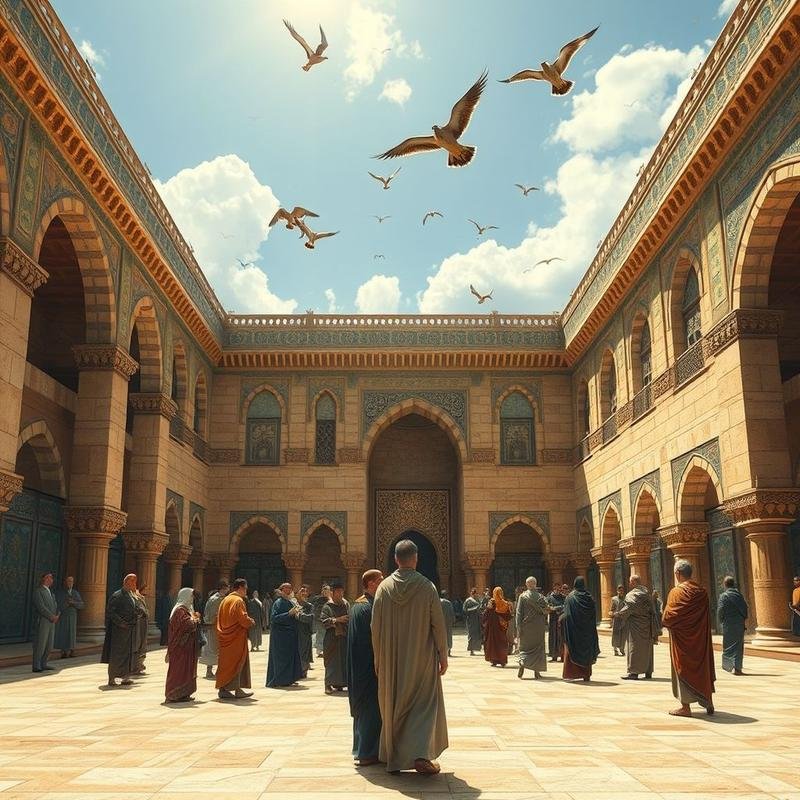The Umayyad Caliphate: A Catastrophic Decline 📜 What Precipitated Its Fall?

Umayyad Caliphate: Rise and Fall Explained
The Umayyad Caliphate stands as a pivotal, yet contentious, era in Islamic history. Was it a golden age of prosperity and justice, or a period marred by conflict and bloodshed? Did it effectively propagate Islam, or did it exploit the religion for territorial expansion? This exploration delves into the history of this dynasty that profoundly shaped the world.
The Rise of the Umayyads
The narrative begins in 661 AD, following a period of instability within the Rashidun Caliphate. With the martyrdom of Ali ibn Abi Talib (may God be pleased with him) and the subsequent transfer of power by Al-Hasan ibn Ali to Muawiyah ibn Abi Sufyan, the caliphate transitioned to the Umayyad house, marking the establishment of the first hereditary dynasty in Islamic history. Muawiyah, a skilled diplomat and astute politician, successfully unified the Muslim community after years of division and laid the groundwork for a strong and expansive state. He relocated the capital from Kufa to Damascus, establishing a new administrative center that reflected a shift from a primarily religiously oriented state to one with a more pronounced political and administrative character.
Internal Strife and Conflict
However, the succession of Yazid ibn Muawiyah after his father’s death reignited internal strife. His reign was marked by the tragedy of Karbala in 680 AD, a devastating event that continues to resonate throughout the Islamic world. The martyrdom of Hussein ibn Ali (may God be pleased with him), the grandson of the Prophet Muhammad (peace be upon him), at the hands of Yazid’s forces, ignited a protracted conflict between the Umayyads and their opposition, a conflict that spanned generations and caused deep divisions.
Yazid’s reign was not solely defined by the tragedy of Karbala; it also included the siege of Mecca in 683 AD, during which the holy city was bombarded, an act that incited widespread outrage among Muslims. Following Yazid’s death, his son Muawiyah II briefly assumed the caliphate for a few months before abdicating, plunging the Umayyad Caliphate into a period of chaos and instability.
The Marwanid Dynasty and Consolidation
Amidst this turmoil, Marwan ibn al-Hakam emerged and, through his political acumen, restored order and established the Marwanid branch of the Umayyad dynasty. Although his reign was brief, Marwan successfully laid a firm foundation for state stability and paved the way for the succession of his son, Abd al-Malik ibn Marwan.
Abd al-Malik ibn Marwan: A Golden Age
Abd al-Malik ibn Marwan is regarded as one of the most significant Umayyad caliphs. His reign was characterized by prosperity and stability, and he implemented crucial administrative, financial, and military reforms. He Arabized the Diwans, establishing Arabic as the official language of administration, introduced Islamic currency to replace foreign currencies, and established a postal system to improve communication throughout the state. He also expanded the Al-Aqsa Mosque and constructed the Dome of the Rock, an architectural masterpiece that remains a testament to the grandeur of Islamic civilization.
During the reign of Abd al-Malik ibn Marwan, the Islamic conquests reached their zenith, with Muslim armies advancing to the far east and west. In the east, the Muslim commander Qutayba ibn Muslim reached the borders of China, while in the west, the Muslim commander Musa ibn Nusayr crossed the Strait of Gibraltar, initiating the conquest of Andalusia and opening a new chapter in Islamic history.
Expansion and Prosperity Under Al-Walid
Upon Abd al-Malik’s death, his son Al-Walid ibn Abd al-Malik succeeded him, continuing the trajectory of prosperity and expansion. During his reign, Andalusia was conquered under the leadership of Tariq ibn Ziyad in 711 AD, becoming an integral part of the Umayyad Caliphate and a center of Islamic civilization in Europe. His reign also saw the construction of the Umayyad Mosque in Damascus, a magnificent structure that reflects the splendor of Islamic architecture.
Later Caliphs and Seeds of Decline
Al-Walid was followed by other Umayyad caliphs, including Sulayman ibn Abd al-Malik and Umar ibn Abd al-Aziz, who is considered the fifth of the Rightly Guided Caliphs due to his just rule and piety. Umar ibn Abd al-Aziz implemented significant reforms aimed at achieving social justice, restoring rights, and combating corruption, earning him widespread admiration among Muslims.
After the death of Umar ibn Abd al-Aziz, Yazid ibn Abd al-Malik assumed the caliphate, followed by Hisham ibn Abd al-Malik, whose reign experienced some unrest but maintained overall stability. Hisham was succeeded by Al-Walid ibn Yazid, whose reign marked the beginning of the decline of the Umayyad Caliphate. Al-Walid ibn Yazid’s recklessness and disregard for state affairs provoked widespread discontent and led to rebellions against his rule.
The Fall of the Umayyad Caliphate
In 744 AD, Al-Walid ibn Yazid was assassinated, plunging the Umayyad Caliphate into a period of chaos and turmoil, with widespread revolts and internal strife. He was briefly succeeded by Yazid ibn Al-Walid, then Ibrahim ibn Al-Walid, and finally Marwan ibn Muhammad, who is considered the last of the Umayyad caliphs.
During the reign of Marwan ibn Muhammad, the rebellions against the Umayyads intensified, and the power of the Abbasids grew, enabling them to garner popular support. In 750 AD, the Umayyad and Abbasid armies clashed in the Battle of the Zab, resulting in the defeat of the Umayyads, the death of Marwan ibn Muhammad, and the fall of the Umayyad Caliphate in the Levant.
The Umayyad Caliphate of Cordoba
However, following the collapse of the Umayyad Caliphate in the Levant, Abd al-Rahman ibn Muawiyah, a grandson of Hisham ibn Abd al-Malik, fled to Andalusia, where he established the Umayyad Caliphate of Cordoba in 756 AD. This state endured for three centuries and became a prominent center of Islamic civilization in Europe.
The Umayyad Caliphate in Andalusia was characterized by prosperity and advancement in various fields, including science, the arts, architecture, and literature. Cordoba, the capital, experienced a significant cultural and scientific renaissance, attracting scholars and intellectuals from across the globe.
Nevertheless, the Umayyad Caliphate in Andalusia was not immune to internal conflicts and periods of instability, which ultimately led to its decline and fragmentation into smaller states, known as the Taifa kingdoms, in 1031 AD.
Factors Contributing to the Decline
What factors contributed to the fall of the Umayyad Caliphate? These can be summarized as follows: First, internal power struggles and strife that weakened the state. Second, discrimination against non-Arab converts to Islam (Mawali), which fueled resentment and led them to join rebellions against the Umayyads. Third, mismanagement and corruption that became prevalent in the later years of the state, leading to economic and social decline. Fourth, the rise of the Abbasids, who successfully mobilized popular support and led the revolution that overthrew the Umayyads. Fifth, the killing of Hussein ibn Ali in Karbala, which created a deep schism within the Islamic community and was exploited by the Abbasids to incite conflict against the Umayyads.
Conclusion
The Umayyad Caliphate, with its complexities and contradictions, remains a significant chapter in Islamic history, serving as a bridge between the Rashidun Caliphate and subsequent Islamic states. It left a lasting legacy on Islamic civilization in the areas of administration, politics, architecture, and the arts. Centuries after its demise, the Umayyad Caliphate continues to generate debate and interest, warranting continued study and analysis to understand the past and inform the future. Can we truly comprehend our present without understanding our past? History holds invaluable lessons. Join us as we explore the achievements of civilizations, and subscribe to our channel for new intellectual explorations.








